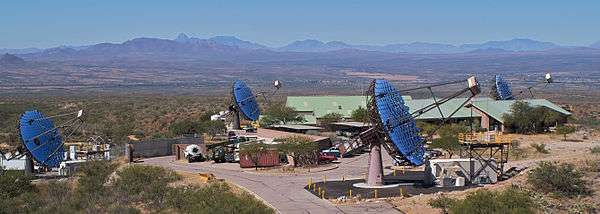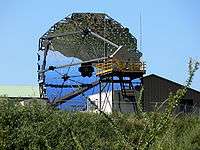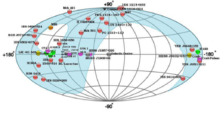VERITAS
 VERITAS – array of four telescopes | |
| Alternative names |
Very Energetic Radiation Imaging Telescope Array System |
|---|---|
| Observatory |
Fred Lawrence Whipple Observatory |
| Location(s) | Mount Hopkins, Arizona, US |
| Coordinates |
31°40′30″N 110°57′07″W / 31.6751°N 110.952°WCoordinates: 31°40′30″N 110°57′07″W / 31.6751°N 110.952°W |
| Altitude |
1,268 m (4,160 ft) |
| First light |
1 February 2005, April 2007 |
| Telescope style |
astronomical observatory gamma-ray telescope |
| Number of telescopes |
4 |
| Diameter |
12 m (39 ft 4 in) |
| Angular resolution |
0.1 degree |
| Collecting area |
100,000 m2 (1,100,000 sq ft) |
| Website |
veritas |
 Location of VERITAS | |
VERITAS (Very Energetic Radiation Imaging Telescope Array System) is a major ground-based gamma-ray observatory with an array of four 12 meter optical reflectors for gamma-ray astronomy in the GeV – TeV photon energy range. VERITAS uses the Imaging Atmospheric Cherenkov Telescope technique to observe gamma-rays that cause particle showers in Earth's upper atmosphere. The telescope design is based on the design of the existing 10m gamma-ray telescope at the Fred Lawrence Whipple Observatory. It consists of an array of imaging telescopes deployed such that they permit the maximum versatility and give the highest sensitivity in the 50 GeV – 50 TeV band (with sensitivity from 100 GeV to over 10 TeV). This very high energy observatory, completed in 2007, effectively complements Fermi Gamma-ray Space Telescope due to its large collection area as well as its higher energy bound.
Specifications and design
VERITAS is constructed of four 12 m Imaging Atmospheric Cherenkov Telescopes with an approximate separation of 100 meters (330 feet) from each adjacent telescope.[1] The four telescope array is needed for stereoscopic observations. These stereoscopic observations allow the reconstruction of the particle shower geometry, thus giving precise angular and energy resolution. The angular resolution is acquired by finding the center axis of the spread of the shower on each telescope and tracing those lines until they cross. The intersection of these lines is the direction of the source of the gamma ray. This is depicted on the figure to the right. Each telescope sees the particle shower at a specific region in its camera (shown as grey ellipses), and thus the source of the shower can be found.
Each of the individual telescopes have a 39 feet aperture, 350 mirrors on each dish, and a 3.5 degree field of view. The telescopes are built on a Davies-Cotton optical design, which uses a spherical reflector and is easy to construct and align. This design does cause a small time spread in the signal, but this spread is very small (~ 4 nanoseconds).[2] The camera on each telescope has 499 individual photomultiplier tubes. VERITAS, like other IACTs, are most sensitive to the highest energy cosmic rays. Its full range of sensitivity is from 85 GeV to over 30 TeV (although the spectral reconstruction does not start until at least 100 GeV). The energy and angular resolution depend on the energy of the incident gamma ray but at 1 TeV the energy resolution is ~17%, and the angular resolution is 0.08 degrees. The entire array has an effective area of 100,000 square meters.

In order to distinguish between the background noise (e.g. hadronic showers, starlight, moonlight, and muons)) and the targeted data (i.e. electromagnetic showers produced from gamma rays), VERITAS uses a three-level trigger system. Level one corresponds to the discriminators on each pixel using constant fraction discriminators. Level two is a pattern selection trigger, which selects only photon-initiated showers, which have compact shapes, and background pulses, which have more random distributions. Level three is the array trigger which looks for coincidence between multiple telescopes.[3]
The Cherenkov light that is produced by cosmic rays in the upper atmosphere is very dim, so VERITAS can only observe under clear, dark skies. Observations are not possible under cloudy or rainy skies, or when the moon is bright. This shrinks the observation time to approximately 70–100 hours each month from September until June. The observatory does not collect data in July or August due to local monsoon conditions.
History
The Very Energetic Radiation Imaging Telescope Array System was built as first next generation IACT in the western hemisphere. It was originally planned as an array of seven telescopes, but only four were constructed in the end.[2] Each telescope was based on the design of the Wipple 10 m telescope that is also present at the Fred Lawrence Whipple Observatory but with significant updates to the reflector optics, light collection efficiency, signal chain, and recording electronics. This was perceived as a significant step up from the previous generation of instruments such as Whipple, HEGRA, and Cherenkov Array at Themis.[2] The original VERITAS prototype telescope was installed in April 2003 and saw first light in February 2004.

After, the success of the first telescope, construction was completed on the other three telescopes in January 2007, and the first light celebration for the full 4 telescope array was on April 27–28, 2007.[4] More recently, telescope number #1 was moved to a new location for improved sensitivity in the summer of 2009. For historical reasons, telescopes number #1 and #4 were built only 35 meters (115 ft) apart, which almost made them redundant in the array. After the move, the sensitivity of the array was increased by 30% corresponding to a 60% decrease in time to detect a source.[1] Furthermore, in the summer of 2012 all of the camera photomultipliers were upgraded to high-quantum-efficiency photomultipliers, which again increased the sensitivity especially near the low end of the energy range.[5]
Science
VERITAS cosmic ray observations further the study of astrophysical objects that emit high-energy cosmic rays, such as:[4]
- Supernova remnants
- Pulsars
- Globular clusters
- Active Galactic Nuclei
- Dark Matter
- Gamma-ray Bursts
- Unidentified sources of cosmic rays
The study of these objects has been going on since 2008, and there have been a number important scientific highlights. In its first year of operation, VERITAS detected two new sources with TeV energy, as well as the detailed studies of two Supernova remnants.[6]
From 2007 to 2011, VERITAS observed the Crab Pulsar and noted a significant source above hundreds of GeVs, which was seen as incompatible with the theoretical models of pulsars.[7]

A large portion of the observation time ( ~400 h per year), has been used to observe ~128 Active Galactic Nuclei and has identified many blazars as well as performed deep studies of known sources.[7]
VERITAS also has an extensive Dark Matter program, in which indirect searches are conducted to find very high energy gamma rays resulting from the annihilation of Dark Matter particles. Most of these searches are conducted at the Galactic Center and in dwarf spheroidal galaxies.[7]
Collaboration
VERITAS is supported by the United States Department of Energy, the National Science Foundation, the Smithsonian Institution, the Natural Sciences and Engineering Research Council in Canada, Science Foundation Ireland and the Particle Physics and Astronomy Research Council in the U.K.
The collaboration is composed of several members and other collaborating institutions.
Member institutions
Collaborators
- Adler Planetarium
- Argonne National Laboratory
- Barnard College
- Columbia University
- DePauw University
- DESY
- Grinnell College
- Georgia Institute of Technology
- University of California, Santa Cruz
- University of Iowa
- University of Massachusetts Amherst
- Cork Institute of Technology
- Galway-Mayo Institute of Technology
- National University of Ireland Galway
See also
References
- 1 2 Perkins, Jeremy S.; Maier, Gernot; The VERITAS Collaboration (2009). "VERITAS Telescope 1 Relocation: Details and Improvements". arXiv:0912.3841 [astro-ph.IM].
- 1 2 3 Krennrich, F.; Bond, I. H.; Boyle, P. J.; Bradbury, S. M.; Buckley, J. H.; Carter-Lewis, D.; Celik, O.; Cui, W.; Daniel, M.; d'Vali, M.; de la Calle Perez, I.; Duke, C.; Falcone, A.; Fegan, D. J.; Fegan, S. J.; Finley, J. P.; Fortson, L. F.; Gaidos, J.; Gammell, S.; Gibbs, K.; Gillanders, G. H.; Grube, J.; Hall, J.; Hall, T. A.; Hanna, D.; Hillas, A. M.; Holder, J.; Horan, D.; Jarvis, A.; et al. (2004). "VERITAS: The Very Energetic Radiation Imaging Telescope Array System". New Astronomy Reviews. 48 (5–6): 345. arXiv:astro-ph/9907248. Bibcode:2004NewAR..48..345K. doi:10.1016/j.newar.2003.12.050.
- ↑ Weekes, T. C.; Badran, H.; Biller, S. D.; Bond, I.; Bradbury, S.; Buckley, J.; Carter-Lewis, D.; Catanese, M.; Criswell, S.; Cui, W.; Dowkontt, P.; Duke, C.; Fegan, D. J.; Finley, J.; Fortson, L.; Gaidos, J.; Gillanders, G. H.; Grindlay, J.; Hall, T. A.; Harris, K.; Hillas, A. M.; Kaaret, P.; Kertzman, M.; Kieda, D.; Krennrich, F.; Lang, M. J.; Lebohec, S.; Lessard, R.; Lloyd-Evans, J.; et al. (2002). "VERITAS: The Very Energetic Radiation Imaging Telescope Array System". Astroparticle Physics. 17 (2): 221. arXiv:astro-ph/0108478. Bibcode:2002APh....17..221W. doi:10.1016/S0927-6505(01)00152-9.
- 1 2 "VERITAS Homepage". Smithsonian Astrophysical Observatory. Retrieved 13 April 2015.
- ↑ Kieda, David (2011). "Status of the VERITAS Upgrade". Proceedings of the 32nd International Cosmic Ray Conference (ICRC2011). 9: 14. arXiv:1110.4360. Bibcode:2011ICRC....9...14K. doi:10.7529/ICRC2011/V09/0343.
- ↑ Holder, J.; Acciari, V. A.; Aliu, E.; Arlen, T.; Beilicke, M.; Benbow, W.; Bradbury, S. M.; Buckley, J. H.; Bugaev, V.; Butt, Y.; Byrum, K. L.; Cannon, A.; Celik, O.; Cesarini, A.; Ciupik, L.; Chow, Y. C. K.; Cogan, P.; Colin, P.; Cui, W.; Daniel, M. K.; Ergin, T.; Falcone, A. D.; Fegan, S. J.; Finley, J. P.; Finnegan, G.; Fortin, P.; Fortson, L. F.; Furniss, A.; Gillanders, G. H.; et al. (2008). "Status of the VERITAS Observatory". AIP Conference Proceedings. p. 657. arXiv:0810.0474. doi:10.1063/1.3076760.
- 1 2 3 Galante, Nicola; for the VERITAS Collaboration (2012). "Status and Highlights of VERITAS". AIP Conference Proceedings: 202. arXiv:1210.5480 [astro-ph.HE]. doi:10.1063/1.4772234. Cite uses deprecated parameter
|class=(help)
External links
| Wikimedia Commons has media related to VERITAS. |